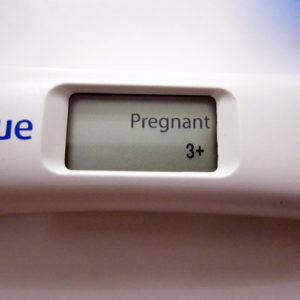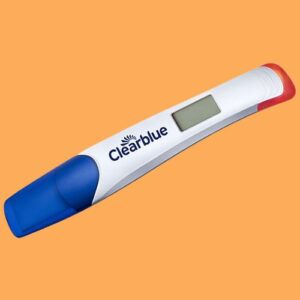The Relationship Between Luteinising Hormone (LH) and Ovulation Kits
Urine always contains some amount of luteinising hormone, but the level increases about 24 – 48 hours before ovulation. It’s the surge in LH that signals your ovary to release an egg. You are at your most fertile during the ovulation phase of your cycle.
Why Use an Ovulation Kit or Fertility Monitor?
For couples trying to conceive, timing is everything. Identifying the fertile window – the few days leading up to and including ovulation – is crucial for increasing the chances of pregnancy. That’s where ovulation kits and fertility monitors come into play. These handy tools take the guesswork out of tracking your cycle, making it easier to pinpoint your most fertile days.
How Ovulation Kits and Fertility Monitors Work
Ovulation kits detect the surge in luteinizing hormone (LH) that occurs 24-48 hours before ovulation. By testing your urine daily with these kits, you can identify the LH surge and know that your fertile window is approaching. Fertility monitors, on the other hand, not only detect the LH surge but also measure other fertility hormones like estrogen, providing a more comprehensive picture of your cycle.
Advantages of Using Ovulation Kits and Fertility Monitors
One of the key advantages of using ovulation kits or fertility monitors is increased accuracy. Rather than relying on guesswork or traditional methods like basal body temperature charting, these tools give you a clear indication of when you’re most fertile. This can be especially helpful for women with irregular cycles or those who have difficulty identifying ovulation signs.
Another benefit is convenience. With ovulation kits and fertility monitors, you don’t have to spend hours meticulously tracking your body’s signs or analyzing charts. Simply follow the instructions, and the kit or monitor will do the work for you, making the process of trying to conceive less stressful and more straightforward.
Tips for Using Ovulation Kits and Fertility Monitors
- Start testing a few days before your expected fertile window. This ensures you don’t miss the LH surge.
- Test at the same time each day, as LH levels can fluctuate throughout the day.
- Follow the instructions carefully, as different kits and monitors may have slightly different procedures.
- Be patient. It can take a few cycles to get the hang of using these tools and identifying your fertile patterns.
When to Seek Professional Help
While ovulation kits and fertility monitors can be incredibly helpful, it’s important to remember that they are not a guarantee of conception. If you’ve been trying to conceive for over a year (or six months if you’re over 35), it may be time to consult a fertility specialist. They can evaluate your situation and recommend additional testing or treatments if necessary.
Ovulation Tests and the Best Time to Use Them
Firstly you need to determine which day is going to be the best day to start testing, and to do that you can use your monthly cycle as a base. Generally, ovulation kits don’t have any set time in which they must be used but some brands may suggest the first visit to the bathroom after waking is the best – this is not compulsory however. It is important to pick a convenient time as this is the time you should use every day when conducting a test.
A fertility monitor will give you the ability to chart your ovulation over the months. Many hopeful mothers to be can find a fertility monitor more accommodating and simpler to manage than keeping track of cervical mucus and basal body temperature. Others combine the two methods to remove any doubt that they are reaching their time for ovulation.
You can buy Ovulation Tests on this website at very reasonable prices.
Are Ovulation Tests Accurate?
The accuracy of ovulation tests has been calculated at around the 99% mark for determining an increase in LH content in the urine.
What Do I Do If I Don’t See a Surge in LH?
If you fail to see any indication of an LH surge during your days of testing then it is highly likely that you have not ovulated. Sadly, your only option is to continue with testing and keep a watch out for indications that you have ovulated.
I’ve Been Monitoring Ovulation for Months and I’m Not Pregnant – What Happens Now?
Despite what your parents told you, getting pregnant isn’t as easy as you might suppose. Many normal healthy couples can take up to 12 months to achieve conception. There are quite a lot of factors at play that can hamper your ability to get pregnant, even if you manage to have intercourse during the most fertile part of your cycle. If after several months of repeated efforts you are still not pregnant make an appointment with your physician. With all of the monitoring you have been doing you will be able to hand over accurate records detailing your ovulation cycle.
Timing Your Intercourse for Best Results
Three days directly after you receive a positive ovulation test result is the most optimum time to have intercourse for the best chance of conception. The first or second day will be immediately prior to ovulation, and the third day will be the actual day of ovulation.
Are There Any Conditions or Medications That Can Affect the Outcome of the Test?
You could receive skewed test results due to the following scenarios:
- You are pregnant
- You were pregnant just recently
- You are menopausal
A few prescription drugs can also affect the outcome of a test result. Serophene® and Clomid® patients (Clomiphene citrate) should see their physician to determine an accurate time frame for the start of testing. The general rule of thumb is to begin testing no less than three days after the last tablet is taken.
Is the Test Affected by Hormonal Contraceptives?
Once you have cancelled your use of contraceptive methods, your physician will be the best person to tell you an optimum time for starting your attempts at getting pregnant. Cessation of contraceptive methods could create irregularities in your cycle. Waiting until your cycle stabilizes is a fairly accepted standard, as this can make it somewhat easier to watch out for ovulation. Another suggestion is to wait until you have completed two normal cycles before using ovulation testing kits.
The Quickest Way to Check If You Are Pregnant
The optimum time to test for pregnancy is on the date you expect your menstrual flow to start. Many tests on the market suggest testing up to four days prior but the results are not as accurate. you can buy early pregnancy tests on our website at very reasonable prices.
Photo credit; “Love” by Anthony Cunningham for Zoom Baby
Zoom Baby is a leading supplier of Pregnancy Tests and Ovulation Test Kits





